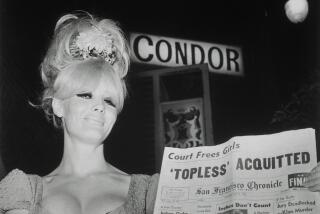From Manet to Madonna
- Share via
When the French painter Edouard Manet used the prostitute Victorine Meurent as the model for his 1863 nude portrait “Olympia,” she wore only an expression that was a cross between scornful and salacious. Paris critics condemned the painting as “an unbelievable vulgarity.” Now “Olympia” is hailed as an Impressionist masterpiece.
Madonna, in defending her baring of her breasts in the movie “Truth or Dare,” says, “I’m not just showing a breast. . . . I’m challenging the mores and ripping open the taboos and turning up the underbelly of our society.”
Madonna’s movie is hardly in the same category as “Olympia,” but the basic point is the same: One man’s--or woman’s--vulgarity is another’s masterpiece. This is why so much “expressive conduct”--including movies, dance, art, flag burning or wearing a black arm band--has long been protected under the First Amendment’s necessarily broad freedom-of-speech guarantees.
But determining what expressive conduct is permissible has always been extremely tricky.
What’s troubling about last week’s U.S. Supreme Court decision upholding an Indiana requirement that nude dancers in a bar wear G-strings and pasties is that the justices redefine “permissible” expressive conduct so unconvincingly--and in a fashion that may signal broader restrictions ahead.
Writing one of three opinions for the 5-4 majority, Chief Justice William H. Rehnquist conceded that nude dancing is expressive conduct within the “outer perimeters of the First Amendment.” But when expressive conduct collides with the state’s “substantial . . . interest in protecting order and morality” from the “evil” of public nudity, the state can require a cover-up.
Yet the logic is not convincing. As Justice Byron R. White noted in dissent, “a nude ballet at Lincoln Center . . . may not differ in substance from the dance viewed by the person who . . . wants some ‘entertainment’ with his beer or shot of rye.”
When government officials try to make “principled” decisions on matters of taste and style, the danger is that, at best, they eventually look foolish and, at worst, downright repressive.
More to Read
The biggest entertainment stories
Get our big stories about Hollywood, film, television, music, arts, culture and more right in your inbox as soon as they publish.
You may occasionally receive promotional content from the Los Angeles Times.









